
Your shopping cart is empty!

Powerboat Hulls Explained
|
Power boat hulls are divided into three main types namely, Displacement, Semi-displacement and Planing hulls. Each hull type can have many sub types, which are closer to one or other end of the spectrum. Considering each hull configuration in detail will reveal its benefits and disadvantages, your choice will be influenced by your intended usage and the size of your wallet. The size of your intended power boat will also be a factor in your choice of hull type; for instance if you are considering a large power boat (large is a relative term) then you will be less likely to choose a full planing hull. Large fast planing hulls require large expensive engines and use large amounts of fuel and operating costs are high. Below are the outlines of the qualities of the various types of power boat hulls. Starting at the Displacement end of the range, these were the first to be developed and to go back to the beginning of time; the original log canoe and even the ark (as far as we know) were all displacement hulls.
Once the most economical speed is achieved, it takes a considerable amount of power to make a displacement hull go faster. When this type of hull is over driven then the stern will drag in the water and usually create a large stern and bow wave. The boat may reach such an extreme bow high, stern down angle, where water could come in over the stern and swamp the vessel. Displacement hulls should not be driven much in excess of their "hull speed". For vessels ranging in size from 30 ft / 9.1 M to 60 ft / 18.3 M waterline length, you should consider displacement hulls only if your speed requirement is around the 6 to 11 knot mark respectively. For higher speeds consider Semi-displacement or Planing hulls. One important factor is that Displacement and Semi-displacement hulls are generally considered better ‘Sea Boats’ and are more suitable for serious offshore cruising than the planing hull type. As with heavy displacement hulls, medium displacement hulls are not so affected by weight as the semi-displacement and planing hull types.
The semi-displacement hull will out perform the displacement ‘Hull Speed’ rules and will accept additional power and convert it to additional speed however there are limits to this benefit. Generally speaking for vessels with 30 ft 9.1 M to 60 ft / 18.3 M waterline length, you should only consider Semi-displacement hulls if your speed requirements do not exceed 12 to 16 knots. As you have seen with displacement hulls additional power is wasted, however with semi-displacement hulls often the extra power may be utilised to advantage. If you already have access to a certain size of engine; or you already own the engine(s), then this factor may assist you in making the decision as to which type of hull best suits your situation As with Displacement hulls, Semi-Displacement hulls can be driven harder, but at the expense of greater fuel consumption and again the stern will tend to dig in at higher speeds. Existing semi-displacement hulls can be made to achieve extra speed with the same horsepower by adding trim tabs or planing wedges at the stern. The trim tabs and the wedges will be fixed after trials are completed to establish the best angle. In no case should you try to improve the performance of your hull in this manner without the assistance of professional advice. If you are building a Semi-Displacement hull, you should try and keep the weight to reasonable levels. The Semi-Displacement hull is a good weight carrier but it takes additional power and fuel to get the best out of an over weight boat of this type. Finally this is the type I would personally choose when planning to undertake extended cruising, that is cruising that regularly involves cruising distances of over 100 miles from home base.
You will often hear the terms 'Deep V' or 'Moderate V'. These terms are meant to convey the amount of V at the transom and in addition to this they do express two different types of hull. A true 'Deep V' hull will have 20 to 24 degrees of V at the transom while a Moderate V hull is one with around 15 degrees of V at the transom. The area in between 16 and 19 degrees can be described either way by the particular designer or builder of the particular boat. Suffice to say that a hull with a V at the transom or 20 degrees or over can be safely classified as a deep V and in my opinion should not be described as a long distance or passage making cruising powerboat.
When deep V hulls were introduced they were touted as the last word in planing hull design. These hulls do perform well at high speeds in rough water which is one reason that they are so successful as racing powerboats. Deep V planing hulls, depending on the particular design, can be driven at speeds in excess of 50 knots, however most are designed to cruise at speeds between 30 to 35 knots. Modern computers can accurately estimate the power requirements and speed expectations of all hull types and are especially helpful in the case deciding the power needed for individual planing hulls. Planing hulls are very popular, they make great pleasure boats if you are prepared to install sufficient power and pay the larger fuel bills. Planing hulls do not like being operated at low speeds; they throw a most unfriendly bow wave. Planing hulls are not the best of sea boats especially in severe conditions. For local and coastal cruising it is worth noting that a planing hull may allow you to get home before the bad weather arrives. If your type of cruising lends itself to the advantages of a planing and if the disadvantages including high cost of operation do not bother you, then by all means consider this type. In this case a moderate V hull is recommended. On no account select a planing hull if you intend to operate your boat in the canal systems of USA or Europe. These hulls are not suitable if your cruising area is restricted to low speed operation. Our stance here at Fine Line Boat Design is that with the large amount of fuel and resultant pollution caused by planing hulls when compared to the displacement hull form shape is unacceptable and thus we no longer sell planing hulls.
|
Horsepower Vs Speed
|
|
| Longboat 21 | Displacement | 3000 | 1360 | 20 to 40 | 6 to 8 |
| Waverunner 22 | Semi-Displ. | 6500 | 3000 | 20 to30+ | 6 to 10 |
| Waverunner 25 | Semi-Displ. | 9800 | 4450 | 33 to 75 | 7 to 12 |
| Coastworker 25 | Semi-Displ. | 8500 | 3860 | 100 to 130 | 10 to 12 |
| Coastworker 25 | Displacement | 8500 | 3860 | 50 | 8 |
| Waverunner 28 | Semi-Displ. | 10000 | 4550 | 33 to 120 | 8 to 12 |
| Coastworker 30 | Displacement | 14480 | 6570 | 65 to 100 | 8 to 10 |
| Coastworker 30 Mk II | Semi-Displ. | 13850 | 6300 | 85 to 180 | 8 to 13 |
| Waverunner 34 | Semi-Displ. | 17000 | 7710 | 50 to 150 | 8 to 12 |
| Waverunner 38 | Semi-Displ. | 30000 | 13610 | 120 to 185 | 9 to 12 |
| Cat 39 Power/Sailor | Twin Hulled | 24640 | 11200 | 2x50 to 2x180 | 8 to 25 |
| Waverunner 40/42 | Displacement | 28000 | 12727 | 80 to 100 | 8 to 10 |
| Waverunner 44 | Semi-Displ. | 44000 | 20000 | 120 to 250 | 10 to 14 |
| Waverunner 45 | Semi-Displ. | 46000 | 20865 | 120 to 250 | 10 to 15 |
| Custom Cat 46 | Twin Hulled | 34000 | 15420 | 2x80 to 2x350 | 12 to 24 |
| Waverunner 52 | Semi-Displ. | 58000 | 26310 | 250 to 450 | 10 to 14 |
| Waverunner 55 | Semi-Displ. | 57600 | 26130 | 260 to 450 | 10 to 15 |
| Waverunner 65 | Semi-Displ. | 81540 | 37000 | 250 to 500 | 10 to 16 |
Displacement is an A VERAGE E STIMATED D ISPLACEMENT of a amateur built vessel.
There are no products to list in this category.
9 Types of Boat Hull Designs and Their Advantages
Imagine gliding through the crystal-clear waters, the gentle breeze kissing your face as your boat slices through the waves effortlessly. While the allure of the open sea is undeniable, what often goes unnoticed is the intricate dance between water and hull that makes this experience possible. Boat hull designs, the unsung heroes of maritime engineering, play a pivotal role in shaping a boat’s performance, handling, stability, and overall characteristics. Whether you’re an avid sailor, a leisurely cruiser, a competitive racer, or a dedicated angler, the type of hull beneath your vessel can make all the difference in your aquatic adventures.
Just as each sailor has their unique voyage, every body of water has its own temperament. The marriage between hull design and boating needs is a testament to the versatility of maritime engineering. From tranquil lakes and meandering rivers to tumultuous oceans and challenging bays, different conditions necessitate distinct hull designs. A flat-bottomed hull might offer stability and shallow-water access for a peaceful day on a calm lake, while a deep-V hull could provide the agility and seaworthiness required to navigate through unpredictable ocean swells. As the water varies, so do the demands on the boat’s performance, and it’s the hull’s responsibility to rise to the occasion.
In this comprehensive guide, we embark on a journey through the fascinating world of boat hull designs. We’ll navigate the intricate waters of hull anatomy, exploring the nuances of design that distinguish one type from another. Whether you’re a seasoned sailor or a novice boater, this guide aims to provide you with a deep understanding of the various types of boat hull designs and the unique advantages they offer. So, whether you’re seeking the thrill of high-speed racing, the tranquility of leisurely cruising, the art of angling, or the adventure of exploration, your choice of hull design can be your most steadfast companion on the water, shaping your experience in ways you might never have imagined.
The Role of Boat Hull Designs
At the heart of every boat’s performance and characteristics lies its hull design—an engineering masterpiece that defines how the vessel interacts with its aquatic environment. The hull is not merely the shell that holds the boat together; it is a dynamic and intricate component that significantly influences various aspects of boating. From stability to speed, maneuverability to efficiency, the hull design serves as the cornerstone upon which a boat’s capabilities are built.
Stability is perhaps one of the most fundamental attributes affected by hull design. The shape and dimensions of the hull determine how the boat sits in the water, its resistance to rolling, and its ability to maintain an even keel. A wider, flat-bottomed hull offers greater initial stability, making it well-suited for activities such as fishing or leisurely cruising. On the other hand, a narrower hull with a deep-V shape might sacrifice some initial stability in favor of better handling in rough waters and higher speeds.
Speed, a quintessential aspect of boating pleasure, is another realm where hull design takes center stage. The interaction between the hull and water directly impacts how efficiently the boat moves through its medium. A sleek, streamlined hull can reduce drag and enhance hydrodynamics, allowing the boat to achieve higher speeds with less effort. Racing vessels often feature hulls with minimal surface contact, optimizing for speed and agility. Conversely, a displacement hull, designed for displacement-style cruising, is engineered to glide efficiently through the water at lower speeds, making it perfect for long-distance journeys.
Maneuverability, closely intertwined with both stability and speed, hinges on the boat’s hull shape. A hull’s responsiveness to steering inputs, its ability to carve sharp turns or navigate confined spaces, and its resistance to skidding are all influenced by its design. A planing hull, characterized by a flatter shape, can rise up and skim the water’s surface at higher speeds, enhancing maneuverability and responsiveness. In contrast, a hull with a rounded shape might prioritize stability over nimbleness, making it a better fit for leisurely cruising.
Efficiency is a goal that transcends mere performance, impacting the boat owner’s wallet and environmental footprint. The right hull design can significantly affect fuel consumption and overall energy efficiency. A well-designed hull minimizes drag, reducing the amount of power needed to propel the boat forward. This translates to cost savings and a reduced impact on the environment.
Choosing the right hull design is not just an exercise in aesthetics or engineering prowess; it’s a critical decision that directly influences the quality of your boating experiences. Whether you’re seeking the thrill of high-speed runs, the peaceful tranquility of a calm lake, or the efficiency of long-haul cruising, understanding the intricacies of hull design is essential. By aligning your boating aspirations with the right hull design, you can unlock the full potential of your vessel and create memorable adventures on the water.
1. Flat Bottom Hull
A flat bottom hull design refers to a type of boat or watercraft hull that has a relatively flat, wide base with minimal curvature or V-shape. Unlike other hull shapes that have pronounced keels or V-shaped bottoms, a flat bottom hull is characterized by its even and level surface along the entire width of the boat’s bottom. This design is commonly used in various types of boats, ranging from small recreational boats to larger vessels used for specific activities.
Advantages of Flat Bottom Hulls:
- Shallow Water Navigation: One of the primary advantages of flat bottom hulls is their ability to navigate in shallow waters. The absence of a deep keel or pronounced V-shape allows these boats to travel in waters with low depths, such as marshes, lakes with fluctuating water levels, and coastal areas.
- Stability: Flat bottom hulls tend to offer enhanced stability compared to other hull designs. The broad base distributes the boat’s weight over a larger surface area, resulting in reduced rocking and swaying. This stability can be especially beneficial for passengers and crew, making the boat suitable for various activities, including leisure cruising and fishing.
- Calm Water Conditions: Flat bottom hulls are well-suited for calm water conditions, such as lakes, ponds, and slow-moving rivers. Their design minimizes resistance, making them efficient for leisurely cruises and relaxed outings. These hulls are not as well-suited for rough seas or choppy waters, as they lack the ability to cut through waves effectively.
- Maneuverability: The flat bottom design allows for improved maneuverability, particularly at lower speeds. This makes them suitable for activities like fishing, where precise positioning and control are essential. Additionally, their ability to turn in tight spaces can be advantageous for activities like navigating through narrow channels or docking in confined areas.
- Ease of Construction: Flat bottom hulls are generally simpler to construct compared to more complex hull designs. This can result in cost savings in terms of both materials and labor, which may contribute to more affordable boat options for consumers.
- Simplicity and Versatility: Due to their straightforward design, flat bottom hulls are versatile and can be adapted for various purposes. They can be used for fishing, pleasure cruising, transportation, and even as workboats in certain industries.
- Beaching: The flat bottom design enables boats to be easily beached or grounded in shallow waters without causing damage to the hull. This can be useful for activities like picnicking or making temporary stops in shallow areas.
Flat bottom hulls are known for their shallow water navigation capabilities, stability, and suitability for calm water conditions. They are particularly well-suited for activities like fishing due to their maneuverability and ease of use in various environments. However, their design limits their effectiveness in handling rough seas or high-speed applications. When choosing a boat with a flat bottom hull, it’s important to consider the intended use and the specific water conditions in which the boat will be operated.
2. V-Shaped Hull
A V-shaped hull design is a type of boat or watercraft hull characterized by a pronounced V-shape along the bottom of the hull. This design features two sloping sides that come together at a keel or centerline, forming a pointed V at the bow (front) of the boat. The degree of the V-shape can vary, with some hulls having a deeper V angle and others having a shallower angle. V-shaped hulls are commonly used in a variety of watercraft, from small recreational boats to larger vessels designed for specific purposes.
Advantages of V-Shaped Hulls:
- Smoother Ride in Rough Water: One of the primary advantages of V-shaped hulls is their ability to provide a smoother ride in rough water conditions. The V-shaped hull is designed to cut through waves and choppy waters, reducing the impact of waves on the boat and minimizing the discomfort experienced by passengers. This makes V-shaped hulls particularly well-suited for offshore or open water boating where rough conditions are common.
- Better Performance in Rough Water: V-shaped hulls excel in rough waters due to their design’s ability to efficiently displace water downward and outward as the boat moves forward. This reduces the amount of pounding and pitching that can occur in rough seas, resulting in improved stability and comfort for those on board.
- Efficiency in Cutting Through Waves: The V-shaped hull’s sharp bow and keel allow it to effectively cut through waves rather than riding over them. This design helps to reduce resistance and increase the boat’s speed and efficiency when moving through water.
- Versatility for Various Activities: V-shaped hulls are versatile and suitable for a wide range of boating activities. They can be used for offshore fishing, cruising, water sports, and even commercial applications like search and rescue operations. The ability to handle rough conditions makes them a preferred choice for boaters who venture into different water environments.
- Directional Stability: The V-shape of the hull, along with the keel, provides excellent directional stability. This stability is beneficial for maintaining a straight course and accurate steering, especially in challenging conditions where maintaining control is crucial.
- Reduced Roll and Sway: V-shaped hulls typically have a narrower beam (width) compared to flat bottom hulls. This narrower beam contributes to reduced rolling and swaying, providing a more stable platform even in moderate to rough seas.
- Enhanced Performance at Higher Speeds: V-shaped hulls are well-suited for higher speeds, as their design allows them to effectively cut through the water while maintaining stability. This can be advantageous for water sports enthusiasts and those who enjoy cruising at faster speeds.
-shaped hulls are designed to provide smoother rides in rough waters, better performance in challenging conditions, and efficient wave-cutting capabilities. Their versatility makes them suitable for various boating activities, especially in environments where rough seas and choppy waters are encountered. When choosing a boat with a V-shaped hull, it’s important to consider the intended use, as they may not perform as well in very shallow waters or calm conditions compared to flat bottom hulls.
3. Deep V-Shaped Hull

A deep V-shaped hull design is a specific variation of the V-shaped hull, characterized by a more pronounced and deeper V-angle along the bottom of the boat’s hull. This design features two sloping sides that meet at a keel, forming a sharp V-shape that extends from the bow (front) to the stern (rear) of the boat. Deep V-shaped hulls are commonly used in various types of watercraft, particularly those designed for offshore and high-performance applications.
Advantages of Deep V-Shaped Hulls:
- Enhanced Stability: Deep V-shaped hulls offer enhanced stability, especially when compared to shallower V-shaped hulls or flat bottom hulls. The deeper V-angle contributes to better lateral stability, reducing the boat’s tendency to roll from side to side. This stability is particularly advantageous in challenging water conditions where waves and chop can cause significant rocking.
- Improved Handling in Rough Seas: Deep V-shaped hulls excel in rough sea conditions. The design allows the boat to cut through waves and provide a smoother ride, minimizing the impact of waves on the hull and reducing the discomfort experienced by passengers. This makes deep V-shaped hulls ideal for offshore boating, where rough waters are common.
- Better Wave Resistance: The deep V-angle and sharp bow of the hull enable the boat to efficiently slice through waves rather than ride over them. This reduces the amount of water sprayed onto the deck and enhances the boat’s ability to maintain forward momentum, resulting in improved performance in challenging water conditions.
- Offshore Boating: Deep V-shaped hulls are particularly well-suited for offshore boating and long-distance cruising. Their ability to handle rough seas and challenging conditions makes them a popular choice among boaters who venture far from shore. The increased stability and wave-cutting capabilities are crucial for maintaining safety and comfort in open water.
- High-Speed Performance: The design of deep V-shaped hulls allows them to achieve high speeds with greater stability compared to other hull shapes. The ability to maintain control at high speeds is essential for water sports enthusiasts, racing, and other high-performance boating activities.
- Directional Control: The deep V-hull design enhances the boat’s directional control, making it easier to steer and maintain a straight course even in challenging conditions. This control is especially valuable when navigating through tight spaces or crowded waterways.
- Reduced Spray: The deep V-shape helps to direct water away from the boat’s deck, reducing the amount of spray and splash that can occur in rough waters. This feature contributes to a more comfortable and dry ride for passengers.
Deep V-shaped hulls are characterized by their pronounced and deeper V-angle, providing enhanced stability, excellent handling in rough seas, and suitability for offshore boating and high-speed performance. Their design allows them to cut through waves efficiently and maintain control even at high speeds, making them a preferred choice for boaters who prioritize safety, comfort, and performance in challenging water conditions.
4. Modified V-Shaped Hull
A modified V-shaped hull design, often referred to as a “modified V” or “modified deep V,” is a hybrid hull design that combines elements of both deep V-shaped hulls and other hull shapes, such as flat bottoms or planing hulls. This design aims to strike a balance between the stability and wave-cutting capabilities of deep V-shaped hulls and the maneuverability and efficiency of other hull types. Modified V-shaped hulls are commonly found in a wide range of watercraft, from recreational boats to performance-oriented vessels.
Characteristics of Modified V-Shaped Hulls:
- Hull Transition: A modified V-shaped hull typically features a deeper V-shape towards the bow, gradually transitioning to a flatter bottom towards the stern. This combination allows for improved stability in the forward sections and better planing and maneuverability towards the rear.
- Chine: Modified V-shaped hulls often have chines, which are pronounced edges or corners along the sides of the hull. Chines help in redirecting water away from the boat’s hull, enhancing stability and lift.
- Deadrise Angle: The angle of the V-shape is typically less steep than that of deep V-shaped hulls, offering a compromise between stability and maneuverability. This angle allows the hull to handle various water conditions while maintaining a smoother ride.
Advantages of Modified V-Shaped Hulls:
- Stability and Maneuverability Balance: The design of modified V-shaped hulls aims to provide a balanced combination of stability and maneuverability. This makes them versatile and suitable for a range of activities, from leisure cruising to water sports and light offshore boating.
- Smooth Ride: While not as specialized as deep V-shaped hulls, modified V-shaped hulls still offer a smoother ride compared to flat bottom hulls. This is beneficial for maintaining comfort on the water, even in moderate choppy conditions.
- Efficiency and Planing: The flatter sections towards the stern of the hull enable modified V-shaped boats to achieve planing quickly. This efficiency allows for better fuel economy and the ability to reach higher speeds with less effort.
- Versatility: Modified V-shaped hulls are versatile and well-suited for a variety of boating activities. They can handle calm waters for leisurely cruises, but they also have enough stability and control for activities like water skiing, wakeboarding, and tubing.
- Maneuverability: The design of modified V-shaped hulls often includes features like chines, which enhance the boat’s maneuverability. This is particularly advantageous when navigating tight spaces, docking, or performing water sports maneuvers.
- Comfortable Ride: The balance between stability and maneuverability in modified V-shaped hulls contributes to a comfortable and enjoyable boating experience for passengers, even when encountering varying water conditions.
- Adaptability: The design of modified V-shaped hulls can be adapted for various boat sizes and types, making them suitable for both smaller recreational boats and larger vessels with multiple purposes.
Modified V-shaped hulls offer a compromise between stability and maneuverability, making them versatile for a wide range of boating activities. Their design allows for a smoother ride, efficient planing, and the ability to handle different water conditions. This adaptability and balance make modified V-shaped hulls a popular choice for boaters seeking versatility and performance in their watercraft .
5. Round-Bottom Hull
A round-bottom hull design is characterized by a curved and continuous surface along the bottom of the boat’s hull. Unlike other hull shapes with flat or V-shaped bottoms, a round-bottom hull has a smooth and curved profile that extends from the bow to the stern of the boat. This design is often associated with traditional sailboats and historic boat designs.
Advantages of Round-Bottom Hulls:
- Smooth Sailing: One of the primary advantages of round-bottom hulls is their ability to provide a smooth and comfortable sailing experience. The curved shape allows the boat to gracefully glide through the water without abrupt changes in motion, leading to reduced rocking and pitching.
- Minimal Resistance: Round-bottom hulls are known for their minimal hydrodynamic resistance. The lack of sharp edges or flat surfaces reduces friction with the water, allowing the boat to move more efficiently and achieve higher speeds compared to hulls with more complex shapes.
- Efficient in Light Winds: Round-bottom hulls are particularly well-suited for light wind conditions. The smooth curvature of the hull allows the boat to maintain momentum even in gentle breezes, making them ideal for sailboats that rely on wind power.
- Historic and Aesthetic Appeal: Round-bottom hulls are often associated with traditional sailing vessels and historic boat designs. As a result, they hold a strong aesthetic appeal for those who appreciate the elegance and craftsmanship of classic boats.
- Balanced Heeling: The rounded shape of the hull contributes to a more balanced heeling (tilting) motion when sailing in wind. This can enhance the stability of the boat and provide a more comfortable experience for passengers.
- Sailing Performance: Round-bottom hulls can be optimized for sailing performance, allowing boats to respond quickly to changes in wind direction and speed. This responsiveness is crucial for competitive sailing and maneuvering in tight spaces.
- Graceful Appearance: The curvature of a round-bottom hull gives boats a graceful and elegant appearance both in and out of the water. This aesthetic quality is often favored by enthusiasts of traditional boat design.
- Heritage and Tradition: Round-bottom hulls have a rich heritage in boatbuilding and maritime history. Many classic sailboats and traditional vessels feature this hull design, contributing to a sense of tradition and cultural significance.
Round-bottom hulls offer advantages such as smooth sailing, minimal resistance, and a strong aesthetic appeal. They are particularly well-suited for sailing vessels, especially in light wind conditions, where their efficiency and responsiveness shine. These hulls are often associated with historic and classic boat designs, preserving the artistry and tradition of boatbuilding while providing an enjoyable and timeless boating experience.
6. Multi-Hull (Catamaran and Trimaran) Designs
Multi-hull designs refer to boat or watercraft designs that feature two or more hulls instead of a single hull. The two most common types of multi-hull designs are catamarans and trimarans.
Catamarans:
Catamarans have two parallel hulls connected by a deck structure. The hulls are typically symmetrical and provide a wide and stable platform. Catamarans can vary in size from small recreational boats to large luxury yachts and even commercial vessels. The space between the hulls can be used for various purposes, such as living quarters, storage, or amenities.
Trimarans:
Trimarans have three hulls—a central hull and two smaller outrigger hulls, or “amas,” on either side. The central hull is usually larger and provides most of the buoyancy and stability, while the outriggers help with stability and lift. Trimarans offer a balance between the stability of catamarans and the performance of single-hull boats. They are often used in racing and cruising.
Advantages of Multi-Hull Designs:
- Increased Stability: Multi-hull designs, whether catamarans or trimarans, offer enhanced stability compared to single-hull boats. The wide platform provided by multiple hulls reduces the rolling motion, making them more comfortable for passengers, especially in rough seas.
- Reduced Draft: Multi-hull boats typically have shallower drafts compared to single-hull boats of similar size. This allows them to navigate in shallower waters and access areas that might be off-limits to deeper-draft vessels.
- Spacious Interiors: The space between the hulls in catamarans and trimarans can be utilized for various purposes, including cabins, lounges, galleys, and storage. This design allows for more spacious and comfortable interiors, making them popular for liveaboard cruising and luxurious yachts.
- Efficient Sailing Performance: Multi-hull designs often offer better sailing performance than single-hull boats. Catamarans and trimarans have less wetted surface area, which reduces drag and allows for higher speeds, particularly when sailing close to the wind.
- Reduced Heeling: Catamarans and trimarans experience less heeling (tilting) compared to single-hull boats. This is advantageous for both comfort and safety, especially when sailing in windy conditions.
- Sailing Versatility: Multi-hull designs are versatile and can be optimized for different types of sailing, from leisure cruising to high-performance racing. Trimarans, in particular, are known for their speed and agility, making them a popular choice for racing enthusiasts.
- Luxury and Comfort: Large multi-hull designs, especially catamarans, are often used for luxury yachts and charter boats. Their spacious interiors, stability, and amenities make them well-suited for comfortable cruising and entertaining guests.
- Economical Fuel Consumption: Catamarans and trimarans are known for their fuel efficiency due to their reduced drag and efficient hull shapes. This can lead to lower fuel consumption compared to single-hull boats of similar size.
Multi-hull designs, such as catamarans and trimarans, offer numerous advantages, including increased stability, spacious interiors, reduced draft, and versatile sailing capabilities. They are suitable for a range of activities, from sailing and cruising to racing and luxury yachting. The unique characteristics of multi-hull designs make them an appealing choice for boaters seeking enhanced comfort, performance, and functionality on the water.
7. Pontoon Hull Design

A pontoon hull design features a flat, deck-like structure that is supported by two or more airtight cylindrical tubes, known as pontoons. These pontoons are typically located underneath the deck and run parallel to each other along the length of the boat. The deck can be used for various purposes, including seating, storage, and amenities. Pontoon boats come in various sizes, from small recreational vessels to larger party boats and luxury pontoons.
Characteristics of Pontoon Hulls:
- Pontoons: The defining characteristic of pontoon hulls is the use of pontoons, which provide buoyancy and support for the boat. These pontoons are often made from aluminum or other lightweight, buoyant materials and are sealed to trap air inside, ensuring the boat remains afloat.
- Flat Deck: The deck of a pontoon boat is typically flat and spacious, providing ample room for seating, lounging, and various recreational activities. The open deck layout allows for customization and versatility in terms of seating arrangements and onboard features.
- Multiple Pontoons: Most pontoon boats have two or three pontoons, arranged parallel to each other. Some larger models might have more pontoons for increased stability and weight distribution.
- Shallow Draft: Pontoon boats have a shallow draft due to their design, which allows them to navigate in shallow waters without getting stuck. This is particularly useful for exploring lakes, rivers, and calm coastal areas.
Advantages of Pontoon Hulls:
- Stability: Pontoon boats are known for their exceptional stability, thanks to the wide and buoyant pontoons that provide a stable platform. This stability makes them ideal for passengers of all ages, including those who might be prone to motion sickness.
- Versatility: The open deck design of pontoon boats makes them highly versatile. Owners can configure the deck to suit their preferences, whether it’s adding seating, dining areas, fishing amenities, or even watersports features like diving boards or water slides.
- Spacious Interior: Pontoon boats offer generous interior space, allowing for comfortable seating arrangements and the option to accommodate a larger number of passengers. This is particularly advantageous for social gatherings, parties, and family outings.
- Ease of Boarding: Pontoon boats typically have a relatively low profile, making it easier for passengers to board from docks or swim platforms. This can be especially helpful for those with mobility challenges.
- Smooth Ride: Pontoon boats tend to offer a smooth and gentle ride, which is appreciated by those seeking a leisurely boating experience. The buoyant pontoons help absorb waves and reduce the impact of choppy waters.
- Suitable for Fishing: Many pontoon boats are equipped with fishing amenities such as rod holders, livewells, and fish finders. Their stable platform also makes fishing more comfortable and accessible.
- Entertaining: The spacious deck and comfortable seating arrangements make pontoon boats ideal for entertaining guests, whether it’s a casual day out on the water or a festive party.
Pontoon hull designs are characterized by their buoyant pontoons and flat deck. They offer excellent stability, versatility, and spaciousness, making them well-suited for a variety of recreational activities, including cruising, fishing, and entertaining. The ease of customization and comfort they provide make pontoon boats a popular choice among boaters looking for a relaxed and enjoyable on-water experience.
8. Planning Hull Design
A planning hull design is characterized by its ability to lift out of the water onto the surface, or “plane,” at higher speeds. Unlike displacement hulls that move through the water, planning hulls use their speed to create lift, allowing the boat to ride on top of the water’s surface rather than pushing through it. This design is commonly used in powerboats, speedboats, and watercraft designed for activities that require high speeds.
Characteristics of Planning Hulls:
- Shape: Planning hulls often have a flatter, more streamlined shape compared to other hull designs. This shape reduces hydrodynamic drag and allows the boat to transition onto the plane more easily.
- Flatter Stern: The stern (rear) of a planning hull is often flatter and wider, providing stability and a better surface for the boat to lift onto the plane.
- Trim Tabs: Some planning hull boats are equipped with trim tabs, adjustable surfaces on the stern that can be raised or lowered. These tabs help control the boat’s attitude and optimize its planing performance.
Advantages of Planning Hulls:
- High Speeds: The primary advantage of planning hulls is their ability to achieve high speeds by lifting out of the water onto the plane. This reduces hydrodynamic drag and allows the boat to glide more efficiently across the water’s surface.
- Efficient Fuel Consumption: Once on the plane, planning hulls require less power to maintain higher speeds compared to displacement hulls. This results in better fuel efficiency and longer range.
- Quick Acceleration: Planning hulls are known for their quick acceleration. The transition onto the plane allows the boat to rapidly gain speed, which can be advantageous for water sports and recreational boating.
- Responsive Handling: Planning hulls offer responsive and agile handling, making them well-suited for activities that involve quick turns, maneuvers, and changes in direction.
- Reduced Bow Rise: As a planning hull accelerates, the bow tends to rise, which can reduce the operator’s visibility and affect handling. However, many planning hulls are designed with features like stepped hulls or lifting strakes to counteract this effect.
- Versatility: Planning hulls are versatile and can be adapted for various water activities, including water skiing, wakeboarding, tubing, racing, and cruising.
- Agility in Calm Waters: Planning hulls perform best in calm or slightly choppy waters, where they can achieve their maximum speed and efficiency. They are less suitable for rough or turbulent seas.
- Adaptability: Planning hulls can be designed for a wide range of boat sizes and styles, from small runabouts to high-performance offshore racing boats.
Planning hull designs are characterized by their ability to lift out of the water and plane on the surface at high speeds. They offer advantages such as efficient fuel consumption, quick acceleration, and responsive handling. These hulls are commonly used in powerboats and watercraft that prioritize speed, agility, and dynamic water sports experiences.
9. Displacement Hull Design

A displacement hull design is characterized by its ability to move through the water by displacing the water around it, rather than riding on top of the water’s surface like a planning hull. Displacement hulls are commonly found in sailboats, trawlers, and other vessels designed for cruising and long-distance voyages.
Characteristics of Displacement Hulls:
- Shape: Displacement hulls typically have a more rounded and full shape compared to planning hulls. The bow is often more bulbous and less streamlined, which helps to displace water smoothly and efficiently.
- Narrow Stern: The stern (rear) of a displacement hull is often narrower compared to planning hulls. This design reduces turbulence and drag as the boat moves through the water.
- Deep Draft: Displacement hulls generally have deeper drafts, which can be advantageous for stability and reducing the effects of rolling in rough seas.
Advantages of Displacement Hulls:
- Fuel Efficiency: One of the primary advantages of displacement hulls is their fuel efficiency. Because they move through the water rather than plane on its surface, they require less power to maintain cruising speeds. This translates to better fuel economy and longer range.
- Smooth Ride: Displacement hulls offer a smooth and comfortable ride. They glide through the water, reducing the impact of waves and chop, and resulting in a more stable and less jarring experience for passengers.
- Stability: The rounded shape and deeper draft of displacement hulls contribute to their stability, especially in rough seas. This stability is particularly important for cruising and long-distance voyages, where comfort and safety are priorities.
- Less Noise and Vibration: Displacement hulls generate less noise and vibration compared to planning hulls at cruising speeds. This quieter experience enhances the overall comfort of passengers and allows for more enjoyable conversations and activities on board.
- Seaworthiness: Displacement hulls are well-suited for long-distance ocean voyages due to their stability and ability to handle various sea conditions. They are less affected by waves and wind, making them reliable choices for extended cruising.
- Safety: The stability and predictable behavior of displacement hulls contribute to their safety, particularly during rough weather or when navigating through challenging waters.
- Classic Aesthetics: Many classic sailboats and trawlers feature displacement hulls. Their rounded, traditional designs hold a timeless aesthetic appeal that resonates with boating enthusiasts.
- Efficient at Low Speeds: Displacement hulls perform well at lower speeds, making them ideal for leisurely cruising and exploring coastal areas or inland waterways.
Displacement hull designs are characterized by their ability to move through the water efficiently and smoothly. They offer advantages such as fuel efficiency, stability, comfort, and safety, making them suitable choices for cruising, long-distance voyages, and ocean crossings. The design of displacement hulls prioritizes a relaxed and enjoyable boating experience, particularly for those who value comfort and exploration on the water.
Watch Boat hull types explained for beginners | Video
Top 4 FAQs and answers related to What are the different types of boat hull designs and their advantages
What are the advantages of a planning hull design.
Planning hulls excel in speed and agility. They lift out of the water at high speeds, reducing drag and allowing for efficient movement. This design offers quick acceleration, responsive handling, and is suitable for water sports and activities that require rapid maneuvers.
How do V-shaped hulls differ from flat bottom hulls?
V-Shaped Hulls: Have a V-shape along the bottom, provide stability in rough waters, and efficiently cut through waves. Flat Bottom Hulls: Have a wide, flat base, are stable in calm waters, and are ideal for shallow water navigation.
What makes multi-hull designs like catamarans and trimarans unique?
Catamarans: Have two parallel hulls, offering stability, spacious interiors, and reduced draft. They’re versatile for cruising, fishing, and entertaining. Trimarans: Feature a central hull and two smaller outrigger hulls. They balance stability and performance, often used in racing and cruising.
What are the advantages of a displacement hull design?
Displacement hulls are known for fuel efficiency, providing a smooth ride, and excellent stability. They are suitable for long-distance voyages, cruising, and are less affected by waves. Their quietness and comfort make them great for leisurely exploration.

In this comprehensive guide, we’ve explored the diverse world of boat hull designs and their unique advantages. We’ve covered a range of designs, each tailored to specific purposes and water conditions. Whether you’re a recreational boater, an avid angler, a water sports enthusiast, or a seasoned cruiser, understanding these hull designs is crucial for optimizing your boating experience.
From the efficient fuel economy and gentle rides offered by displacement hulls, to the exhilarating speeds and agility of planning hulls, each design comes with its own set of benefits. V-shaped hulls conquer rough seas with stability, while flat bottom hulls navigate shallow waters with ease. Round-bottom hulls offer smooth sailing, and multi-hull designs like catamarans and trimarans balance stability and versatility.
Choosing the right hull design is paramount. Your intended activities, preferred water conditions, and desired experiences all play a role in this decision. Each design has its strengths, but understanding their characteristics empowers you to make an informed choice that aligns with your needs and aspirations.
As you embark on your journey into the world of boating, explore the nuances of different hull designs and their advantages. Whether you’re purchasing a new vessel or customizing an existing one, this knowledge will be your compass. With the insights gained from this guide, you’re equipped to navigate the waters with a deeper understanding, confidently selecting the perfect hull design to elevate your boating adventures. May your sails be steady, your rides be smooth, and your experiences be enriched as you set sail with newfound appreciation and expertise.
Share 9 Different Types of Boat Hull Designs and Their Advantages on a Budget with your friends and Leave a comment below with your thoughts.
Read 8 DIY Modifications to Increase Boat Performance on a Budget until we meet in the next article.
Similar Posts

Do You Need a License to Drive a Boat in New York? Guide
Picture this: It’s a sunny summer day in the Empire State, and you find yourself cruising along the glistening waters of one of New York’s beautiful lakes or rivers. The wind tousles your hair, and the sound of lapping waves creates a soothing rhythm. Boating in New York offers a delightful escape and a chance…

Transforming Pontoon into a Fishing Oasis: Setup Guide
Pontoon boats are synonymous with leisure cruises and relaxing on the water. But what if you crave a touch of angling excitement alongside your suntanning? The good news is, with the right setup, your pontoon can transform into a fish-fighting fortress! This guide delves into everything you need to turn your pontoon into the ultimate…

How Much is a 20-Foot Pontoon Boat? A Comprehensive Guide
Pontoon boats are popular for their versatility, comfort, and the fun they bring to recreational boating. They are great for leisurely cruises, fishing trips, watersports, and social gatherings on the water. Among the different sizes available, the 20-foot pontoon boat is particularly favored for its balance between size and functionality. But how much does a…

5 Ways to Celebrate National Fishing and Boating Week
National Fishing and Boating Week is an exciting time for enthusiasts and newcomers alike, offering a perfect opportunity to indulge in outdoor adventures on the water. Celebrated annually in early June, this week-long event is dedicated to promoting recreational fishing and boating while encouraging people to enjoy the natural beauty of lakes, rivers, and oceans….

Exploring the World of Spirit Boats: Guide
Across cultures and throughout history, vessels carrying the spirits of the deceased have traversed the currents of myth, religion, and folklore. These symbolic boats, often referred to as spirit boats, serve as a powerful reminder of the human belief in an afterlife and the desire to guide the departed on their final voyage. A Global…

5 Essential Winter Boating Tips for Safe, Enjoyable Adventures
Winter boating can be a thrilling way to enjoy the serenity of the water during the quieter, colder months. However, it also presents unique challenges that require careful planning and preparation. Whether you’re navigating icy waters or cruising under a winter sun, these five essential winter boating tips will help you stay safe, warm, and…

- Discussion Forums
- Activity Stream
- Member Blogs
- Buy and Sell Marketplace
- Team Membership
- Advanced Search
- If this is your first visit, be sure to check out the FAQ by clicking the link above. You may have to register before you can post: click the register link above to proceed. To start viewing messages, select the forum that you want to visit from the selection below.
- Feature Boats
- Feature Articles
- New Products
- Racing News
- Industry News
- Engines and Accessories
- Miscellaneous
- Performance Tech
- Event Coverage
- Forum Trending
Sponsored Content
Latest posts.
STV vs Quarter Shot vs Mirage which one is best and why?
Curious which one is the best boat to run and why?

Looking for, OMC V8
Hey guys, on the hunt for an OMC v8, either complete outboard, or a fully runny powerhead. I will even consider a popped motor if damage is not to bad.
V6 OMC Crossflow cowl (white VRO)
make me an offer if anyone needs it.
Is the v8 vking owner on here?
Mercury 280 bogs down sometimes when trimming, shifter sometimes shuts off the motor.
My 1990 STV has a 2-stroke Mercury 2.5L EFI SS (280 hp, powerhead is 2001, other components are older, from 2.4 L EFI days). It has been plagued with
Post your Favorite Memes Here
I laugh every time I see this.
looking for a #6 SSM in good shape.
2.4 efi charging issue
my fuel proplems are solved. now im only getting 12.7v at cruise. its not the stator must be reg/reactifier, i have now a 194-8825k1. i see a million
What is the true hp of 2003 250 efi downdraft
What always led to believe that a stock 2002+ downdraft EFI was 275 hp is that true ?
The Johnson Outboard Motor Show - 1977 Promotional boat show video
I love videos like these, and this one, though sometimes pretty corny, has some really cool sequences in it. This was a promotional video that was shown
Tachometer only reading to 4k
1990 200 Merc - Tach works fine from idle to 4K but will not read over that. I know I am turning more revs thank what it is reading. Didn't have an issue
Bullet experts! What color flake and gelcoat
Help guys. I just got a 1995 21xdc. Can someone please tell me what color or colors of flake I need. I know I need red. And of course black and clear
tire date codes
I am trying to read the date code on my trailer tires. There are two numbers that look like codes 0019429 4813 I think
1979 Viking build
Three times a charm so they say. As of today the hull sits bare, cap separated, all core and transom removed. Layup is going to be balsa core set in ATC
The Bottom Line: How a Pad Makes a Vee-Hull Faster
- View Profile
- View Forum Posts
- View Blog Entries
- Visit Homepage
- View Articles

Thanks Greg---- Great reading and very informative! Gary
That was a great read, Thank you!
OMG! wow is that awesome! i have a Hydrostream Valero Vee and YT and my neighbor is always asking which is better, and this shows why my vee takes less hp to fly! but YT can fly more stabil... Great pics and diagrams, very informative! I am thinking my 85 Valero Vee has a "similar" pad design to an Allison GS? or not? Thank-You! JIM
Awesome stuff. Jim is full of good details and it is backed by experience.
Thanks good read
Great Article as USUAL!!!!!! Thanks Jim for the lesson on "V" design.
A very informative article, thanks for sharing the information Jim and Greg for posting it on S&F.
thanks jim and greg for refreshing my memory on v lesson
That was great reading thanks!!!
Very informative, good read !!
I should look at the homepage more often. Awesome, thanks Jim !
Always a great and informative article from Jim.... He always explains the magic!
Gentlemen, thank you very much for this article. I've been playing with a Hydrostream Valero Vee pad trying to as much as possible on a limited budget. This read has opened quite a bit of information that will help in the long run. Especially considering my friends here in the Tar river drive 1/4 Shots or STV's that enjoy the extra company and encourage my boating habit.
Jim Russell is the best there is and Helmut and I have always been guided by his knowledge and experience. Not only has Jim allowed us to achieve greater performance, but also in a safer manner. I gained much new understanding on the dynamic forces affecting the boat and stability when we reviewed the Tunnel Boat Design Program. I am looking forward to a new evaluation on this very powerful software. Greg
Great reading! Thank you!
Fantastic article! i have a friend who always asks these questions, and you have answered with great graphics and explanations! I am a Stream owner who also loves Alleys. Great boats! Owner Vector, HST and currently 85 Valero Vee, 88 Valero YT. -Jim L.
- Scream And Fly Home
- Privacy Statement
Your browser is out-of-date! You must upgrade to a different browser to experience this site.
All Chapters
- Boating Terminology
Boat Hull Types & Designs
- Boat Engine Types Explained
- Boat Size Classifications
- Boat Capacity
- Hull Identification Numbers
- Boat Registration & Titling
- Life Jacket Types & Designs
- Children's Life Jacket Recommendations & Requirements
- PFD Rules & Requirements
- Life Jacket Fitting & Care Guidelines
- Inflatable PFD Types & Tip
- Boat Fire Extinguishers
- Boat Backfire Flame Arrestor
- Boat Ventilation Systems
- Boat Navigation Light Types & Requirements
- Unpowered Boat Navigation Lights
- Visual Distress Signals
- Marine Distress Signals
- Weather Conditions
- Small Craft Advisory
- Boat Maintenance Tips
- Towing & Trailering
- Launching & Retrieving
- Pre-departure Checklist
- Rendering Assistance
- Capsizing/Falls Overboard
- Cold Water Immersion
- Fire Prevention
- Running Aground Prevention
- Accident Reports
This site requires JavaScript. Your browser either doesn’t support JavaScript or you have it turned off.
For this page to function correctly, please enable JavaScript and then refresh the page.
Boats come in a wide variety of shapes and sizes—and so do their hulls. Despite the variety, all hulls are designed to do one of only two things: either displace water, or ride on top of it, which is called planing. Sailing boats, slow-moving boats, and large boats like cruise ships have displacement hulls. The combination of their weight and power means they move lower in the water, pushing or displacing water, rather than riding on top of it. Smaller, faster boats, like powerboats or personal watercraft, typically have planing hulls. Planing hulls are designed to rise up and ride on top of the water at higher speeds. Now let's look at some specific hull types.
There are four common types of boat hulls.
Flat-Bottom Hulls
Boats with "flat-bottomed" hulls are very stable, great for fishing and other uses on calm, small bodies of water.
Round-Bottom Hulls
"Round-bottomed" hulls are typically displacement hulls, and are designed to move smoothly through the water with little effort. An example of a round-bottomed hull is that found on a canoe. One drawback to the round-bottomed design is that it's less stable in the water and can capsize more easily. So, extra care needs to be taken when entering, exiting and loading these types of boats.
V-Shaped Hulls
"V-shaped" hulls are planing hulls, and are the most common type of hull for powerboats. Deep v-shaped boats are designed to plane on top of the water at higher speeds and provide a smoother ride through choppy water. These boats are usually equipped with a larger engine than flat or round-bottomed boats.
Multi-Hulled
Finally, let's look at "multi-hulled" boats. These boats can have either planing or displacement hulls depending on the shape of hull and size of engine. Multi-hulled boats are some of the most stable on the water. They also require more room to steer and turn. Examples of common multi-hulled boats are catamarans and pontoon boats .
Boat Terminology
Boat Engine Types


Professional BoatBuilder Magazine
Cfd for powerboat design, part 1.
By Clay Ratcliffe , May 24, 2021

Scan data are rendered into digital design files suitable for performing computational fluid dynamics (CFD) modeling like this one to test the hydrodynamic performance of the vessel.
In its earliest days, composite boatbuilding was open to most anyone who could cut fiberglass fabric and spread resin. By and large, builders learned the trade in a repair shop or boatyard. Their expectations and preferences were shaped by the boats they knew. When it came to launching their own brands, they took the hullforms they had an affinity for and added their own secret formulas. Look at any distinctive designs of the ’70s, ’80s, and ’90s, and it’s not difficult to trace how they evolved. Most basic designs, especially the running surfaces, rarely deviated from those of their immediate forebears.
That’s how high-speed powerboats were built and sold—from the bottom up. Boat manufacturers created a brand stereotype from sophisticated charts, pictures, and sales aids promoting the attributes of their particular hull. Some promoted the smooth ride in rough water that characterized variations on a conventional high-deadrise V-shaped bottom. Others pitched the agile, responsive ride of a ventilated hull, while a few promoted the virtues of the very fast but tricky-to-handle pad bottom. Boat buyers who bought the pitch and liked the price, the salesman, and the service shop soon became fans of that hullform and brand.
The recession changed everything as boat sales slumped dramatically in 2008–09. Consumer financing all but disappeared. Dealer and OEM floor planning became a thing of the past. Plus, the BP oil spill killed sales on the entire Gulf Coast for more than a year.

Les Baker, senior applications engineer at FARO Technologies, uses its Super 6DoF TrackArm 3D Scanning System to digitally capture, at a required target accuracy of ±0.004″ (0.1mm), the complex tunnel shape on a 32′ (9.75m) Doug Wright Designs high-performance catamaran.
The market contraction led to a frenzy of corporate consolidation, often driven by investment companies with no background in boatbuilding. Soon hundreds of iconic designs and molds were reduced to line-item entries on a balance sheet. Many new owners of these businesses believed that the tooling and molds that came with an acquisition were worth their weight in gold and had a long shelf life. That was not the case. Without the experienced designers and builders who had built many of these brands, bottom-up boat design and refinement became things of the past. “Let’s bring fresh ideas to the boat business” was a refrain echoed throughout the industry as new managers tried to make a virtue of the experience deficit in their ranks. In lieu of updating hull designs, they added accessories, new upholstery, snazzy, colorful graphics, and cup holders in place of rod holders. Such were the changes that defined the new models being offered to the postrecession boat market.

The New Power Dynamic
About the same time, outboard motor manufacturers made the jump from the 250-hp range to 350 hp and 400 hp or more, and consumers’ appetite for speed pushed builders to install triples and quads. Soon a new problem reared its ugly head—legacy hull designs had not been updated, and many were unable to handle this new outboard power and higher speed.
The old bottom-up solution to creating a new model to accommodate additional horsepower was to flip over a bare hull, gather the team on a Monday morning, and decide what to do. A typical recipe was to lengthen the running surface, add a few lifting strakes, provide a place for built-in trim tabs, and you were good to go. That worked well until we bolted 1,800 hp on the transom, at which point many existing hullforms became untenable and downright scary at the helm.
At 45 mph most late-20th-century high-speed designs perform well in moderate sea conditions. But at 60 mph, unfavorable characteristics become evident to the operator, especially when traversing oncoming wakes or navigating power-on tight turns. At 90+ mph the hull is clearly either able or unable to handle the increased power. There is no cover-up for an unruly, poor-handling boat at that speed. See also our story on the patented Petestep hullform that uses CFD to capture the energy of spray.
Because of their soft, almost cushy ride, hulls with 24° deadrise all the way to the stern are still offered by many builders. But, as three, four, and even five 450-hp outboards are pitched to the consumer, modifications including ventilated hulls and additional lifting strakes are required for safe handling at the speeds necessary to justify the investment in power. In short, as engine choices become more specific to desired high-speed applications, so must hull designs.
As recently as the early 2000s, builders cost-effectively offered different models intended for fishing or for high speeds that were built on the same hull or running surface. That’s no longer possible in the face of today’s market expectations for horsepower and speed.
Let’s take two 42 ‘ (12.8m) boats as examples. One is designed for fishing with a capacity of 10 people, and sports triple helm stations including a “tuna tower.” The other is a high-performance vessel with seating for six and not a rod holder to be found. Both have four 400-plus-hp outboard engines on the transom. Should the hull designs be the same? Absolutely not and for good reason. The same 1,600+ hp serves two totally different applications on these two boats. Load, center of gravity, beam, length of running surface, and other factors must come into play.
Remember Newton’s Third Law from high school physics? “For every action there is an equal and opposite reaction.” The faster the boat, the greater the forces it is subjected to by the water and air it encounters, and the less forgiving it is of design or handling missteps. At high speed the stakes are higher, the tolerances tighter, and the old bottom-up design process must be tweaked. The need for design refinement is clear, but the risk and expense of building a running prototype of a new model based on an existing hullform are too great.
Builders of high-speed powerboats must now turn to new techniques to accurately measure the dynamics of their hulls in action and to predictively model performance changes in response to alterations of the running surface and hull shape.

Two Doug Wright Designs hulls equipped with identical running surfaces. The recreational model at near right benefits from the experience and refinement of the competition model beside it.
In 2019, working with Scott Porta of Porta Performance (New Smyrna Beach, Florida), I oversaw just such a refinement project of an existing hull designed by Doug Wright Designs (Melbourne, Florida). The goal for the already winning model was to improve speed and handling with increased horsepower. With an overall length of 32 ‘ (9.75m) and beam of about 9 ‘ (2.74m), it was designed and built by Wright in 2013 as a true wide-tunnel performance catamaran with maximum running surface for the OAL (as defined by the class rules for “Super Stock” in the Offshore Powerboat Association). Porta had raced several canopy versions of the boat successfully in competition.
“The demand during a race on a 4½- mile offshore closed course requires the boat to accelerate from a 45-mph ‘rolling’ green flag start to nearly 120 mph on the back straightaway,” Porta said. “Then the boat must turn sharply around a corner buoy at 90–100 mph and accelerate through rough seas and the wash from other boats gathering up in the turns. Catamarans are tricky, as the inside hull can catch on a wake or rogue wave and cause a spinout or capsize.” Based on his experience, Porta had some modifications he thought would make the boat run faster and safer, but we wanted to test them efficiently and safely before suggesting any changes to the hull to improve the competition and recreational versions of the boat.
We first explored hydrodynamic model testing. Because this is a 100-mph boat, where aerodynamics is at least as important as how the hull runs on the water, we knew we would need to test in a facility like the 250+ mph wind tunnel at Embry-Riddle Aeronautical University. For a subsonic model and high-speed wind tunnel testing, the costs would be excessive and would take more than six months to complete, so we needed another option.
I had heard of aerodynamic and hydrodynamic testing of boats, cars, and airplanes being done on a computer. I also knew that aerospace, Formula One, and NASCAR were using computers for complex simulation, but I had never used it to model boat performance.
After an initial inquiry into the viability of computerized hydrodynamic modeling, a potential obstacle arose. Before we could input a boat hull design into a computer for simulation, we would need an extremely accurate and precise CAD file of the boat itself. To complete the project and predictively test the hull changes that Porta had in mind using computerized computational fluid dynamics (CFD) modeling, we first needed a very precise 3D scan of the hull and CAD file preparation based on the scan data. Each step would require outside expertise and contractors, but if we got it all right, we could perform the equivalent of the old bottom-up method of modifying lifting strakes and running surface without cutting a single stick, grinding an ounce of fiberglass, or running an actual boat at high speed (and risk) to determine the performance for each change.
3D Scanning: Metrology
Because our case-study catamaran was of a vintage where a relevant CAD file no longer existed, the first step was to 3D scan the boat we had. The technology has been used for years on propellers, engine parts, accessories, and many small parts when there is a need for high precision and replication. But I’d never seen it done on a large, complex shape like a boat.
Typical scanning equipment that can cope with a boat-sized object is either meant for construction applications, which typically have much lower accuracy and resolution over a much bigger volume, or it’s designed for much smaller objects, where the resolution is sufficient but accuracy degrades as the volume increases.
We chose FARO (originally Frasier and Raab Orthopedics) Technologies, a manufacturer of ultraprecise 3D-scanning equipment based in Lake Mary, Florida. Les Baker, the senior applications engineer at FARO, described their technology for 3D-scanning (metrology) a large object: “With the FARO Super 6DoF TrackArm 3D Scanning System, objects of this size can be scanned with high accuracy and superior resolution to capture critical forms with sufficient fidelity.”

A thorough scan of the catamaran hull required three FARO Quantum ScanArms and operators. The FARO Vantage Laser Tracker, at left behind the boat, synchronized all scan locations into a single 3D coordinate system.
FARO’s system basically marries two measurement devices: the laser tracker, designed for very accurate single-point measurements over distances up to more than 500 ‘ (152.4m); and the scan arm, designed for high resolution, contact measurement, and noncontact 3D scanning over a distance of up to 13 ‘ (3.96m).
The laser tracker tells the arm where it is in space and allows it to move around the boat and capture scans at a much higher accuracy than it could on its own. To keep measurements as accurate as possible, the system also monitors temperature, pressure, and humidity in the scanning environment to calculate air density and then compensate for diffraction of the laser beam.
Scanning requires an action similar to spray painting the boat with a 6 “ (152mm) paint band, with each 6 “ pass capturing 2,000 data points, 350 times per second. FARO’s software can reduce the density of the data based on the curvature of the surfaces scanned, thus preserving great detail around complex shapes.
Baker brought a FARO crew to scan the catamaran on-site at Porta Performance. We had to provide ample working room around the hull. Both sponsons were exposed for scanning from the top, bottom, sides, and in the tunnel between them. We positioned the hull above a concrete floor on solid stanchions that were absolutely rigid. The target accuracy requirement for the scan was ±0.004 “ (0.1mm).
The laser tracker and scan arms also required solid mounting with the same rigidity as the boat. Each track arm had a reach of about 6.5 ‘ (2m), which translated to a 13 ‘ working span if fully extended fore-and-aft. With a 32 ‘ boat the arms had to be relocated multiple times. The key was to recalibrate and connect the scans with each new position after the arms were moved, allowing the FARO Laser Tracker to assemble the data from different arm locations into one seamless CAD file. The entire 3D scan with three technicians, over two days, yielded our desired results within the expected tolerance of 0.004 “ or better.
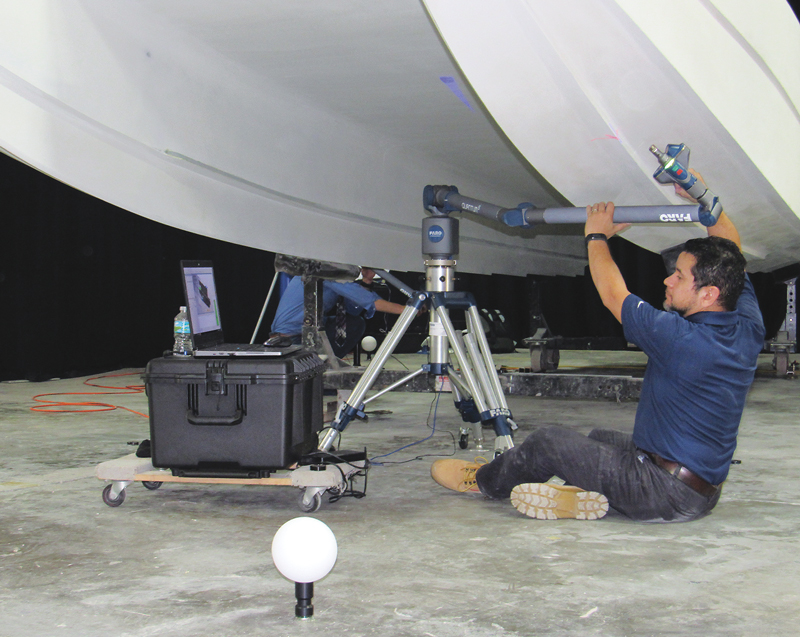
The project required data from a dozen ScanArm locations to cover every square inch of the hull. The end result was a highly detailed 3D “point cloud” model of the entire hull, which became the starting point of the CFD modeling and optimization.
Computer File Preparation
The data from FARO’s hull scan were incredibly accurate but not in a format that could be used for the CFD analysis we had in mind or for a CNC router if we had wanted to cut a direct mold of the scan. Our next step was file compilation and homologation, converting the scan into files that could be read by a 3D printer, 5-axis mill, or CFD program. For this project we turned to Dimensional Engineering Inc. (Houston, Texas) for computer file homologation to create the “watertight STL” (Standard Triangle Language) file we needed.
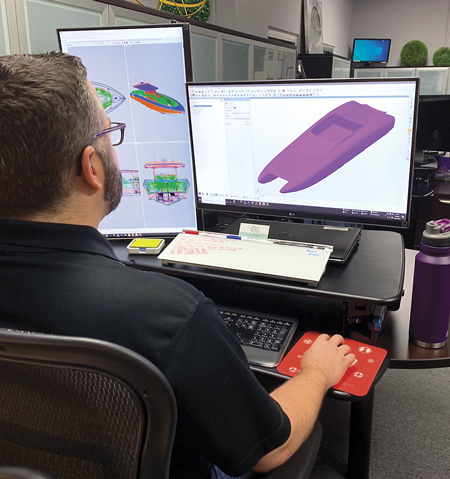
Starting with the data from the scan, Jason Self, lead metrology specialist at Dimensional Engineering, creates a contiguous, faired, watertight STL file (a full digital model) of the catamaran, ready for CFD.
William Bonner, founder of Dimensional Engineering, said it’s important to start with good scan data. “The use of multiple devices is crucial. For example, using an arm scanner alone on an object 32 ‘ in length is nowhere near as accurate as combining it with a laser tracker,” he said. “And a handheld scanner without scale bars and photogrammetry can distort the object. These technologies used without one another can cause major issues in the integrity of the data.”
Once all the data are collected and accuracy is verified, it must be converted into a watertight STL model, which means any holes in the virtual structure must be filled. According to Bonner, most CAD software packages can automatically fill holes, but in some circumstances autofilling can take too much liberty and cause false undulations in the surface, so the results must be analyzed to ensure that the extrapolation of the filled hole is correct.
“The project for the 32 ‘ Doug Wright catamaran was to reverse-engineer the scan data into a CAD model,” Bonner said. This is typical if a new tool needs to be machined. If the scan data are not pristine enough, they will always have imperfections either from the scanning technology, the object itself, or a combination of both. If the model is not perfect, neither will be the results from CFD or a new tool cut from it. With the data, it took Bonner about 10 hours of computer work to create a contiguous and faired watertight STL file (a full computer model) of the 32 ‘ x 9 ‘ offshore high-performance catamaran suitable for printing an accurate 3D model or for CFD modeling.
Testing Hydrodynamics by CFD
With the CAD files in hand, we were ready for the CFD computer modeling of the boat’s performance and Porta’s proposed changes we’d originally set out to assess.
Using CFD to improve hydrodynamics is still far from standard in conventional boat design. Conversely, automotive designers live by it because of the fuel mileage requirements, and auto racing teams will put a new body or part into CFD to measure the drag imposed by a change. In our case, we were taking apart a catamaran that was designed for racing and putting it back together on the computer as a totally new boat, essentially an exercise in reverse engineering.

At TotalSim, CFD tests on the hull (left screen) can be run through different scenarios and conditions yielding a simulated performance based on the calculated forces acting on the hull in motion.
For our CFD work we turned to another expert contractor, Naethan Eagles, technical director at TotalSim US in Dublin, Ohio.
With his help we would look at the existing hull and create a digital twin engineered on the computer with the design speeds and conditions set. The parameters of this case study were: running at 100–130 mph in 3 ‘ –5 ‘ (0.91m–1.52m) chop with little or no crosswind, while keeping the running surface as close to parallel with the surface of the water as possible. The CFD yielded some surprising outcomes.
In a compression tunnel catamaran, the airflow between the hulls is altered and affected by oncoming water conditions—hydrodynamics and aerodynamics collide. We found that the air/water mixture in the tunnel on our boat was reversing direction, creating a backflow on the top of the tunnel moving forward. At 100 mph the forward-moving backflow was leaking out the front of the tunnel and mixing with the airflow over the deck. The intended design was to release tunnel pressure only when the boat launched and left the water. The leaking backflow meant tunnel pressure was significantly reduced from its design parameter.
CFD revealed that the running surface was typical of a ventilated bottom. Hull ventilation was normal and performed as designed, but the lifting strakes created sufficient hydrodynamic drag. We saw that the combination of lifting strakes and chine angle scrubbed off 3–5 mph at a design speed of 130 mph. The combination of confused tunnel flow and disturbed water on the running surface created drag and “dirty” water leaving the transom. Having confirmed what elements were slowing the boat, Porta could work with Eagles to make changes in the CAD files and test performance in CFD as he searched for remedies.

Looking from under the boat toward the surface, this plot shows shear stress (friction) on the hull, flow direction at the surface, and an iso-surface in blue where the air and the surface meet. An overlaid series of 10 clip planes shows energy losses progressing from bow to stern. This combination yields clues as to what is and is not working well for lift and drag.
With this design project, we put the days of risky and expensive on-the-water trial and error behind us. Improved performance, safety, and speed were the desired outcomes from the CFD analysis. We attained them efficiently and safely by using CFD to confirm and build on Porta’s real-world experience running the boat in competition.
Conclusions
Many boatbuilders have a difficult time abandoning what they have been building and selling for years. We found the same to be true in this case. Our study results prompted us to make beneficial changes that yielded championship-winning results. Later findings from the case study have informed more recent performance-boat builds, and some have been integrated into production. Often, seeing is believing, and winning races often becomes a convincing tool.
Through our testing we learned lessons for current and future applications to new designs, such as the integration of hydrodynamic and aerodynamic forces, and lifting strakes causing drag. While the boat designer and builder should never consider technology a replacement for experience, it was clear to us that scanning and CFD tools represent huge leaps forward for the industry. As a practical matter, future modifications to existing models can be efficiently tested on the computer before any tooling is cut or a new mold is created.
Arguably, we have come full circle to a point where recreational boats can again be designed, built, and sold from the bottom-up based on changes to the running surfaces that additional power options require. Safe, efficient, and brisk-handling vessels are essential to the discerning boat buyer. Our experience has convinced me that computer modeling applied to somewhat unconventional design ideas will allow high-speed boat design to move forward in directions that were simply not possible before.
In Part 2 we’ll apply CFD aerodynamic analysis to high-speed boat design refinement and performance analysis.
About the Author: Clay Ratcliffe is a 45+ year veteran of high-performance industry technical design and marketing. After converting from auto to offshore powerboat racing, he has been a catalyst for boatbuilders to bring well established design methods into performance-boat manufacturing. He was project lead on this case study.
Read more Design , Racing , Tools articles

- From Langan Design Partners, a Classic Cutter
Designing, engineering, and building sailing yachts 90′ (27.4m) or more in length once was common in the U.S. It’s happening again at Rockport Marine in Maine: Project Ouzel, a 95′… Read more »

Isobel Combines Classic Looks and Modern Tech
From the drawing board of Stephens Waring Design (Belfast, Maine) comes Isobel, a 26’6″ (8.5m) 1950s-inspired runabout being built at nearby Belmont Boatworks. The boat was commissioned by a longtime… Read more »

Saildrone Launches 65′ Aluminum USV
Richard Jenkins, an Englishman trained in mechanical engineering, stepped into the limelight on March 26, 2009, in California’s Mojave Desert by setting a 126.1 mph (203 km/h) land sailing speed… Read more »

Recent Posts
- Volvo-Penta’s Bid to Future-Proof IPS
- AIRMAR Achieves World’s First OneNet Product Certification
- Infusing a Workboat Hull with Elium
- Counting Carbon with LCA
- Companies (91)
- Construction (115)
- Design (168)
- Drawing Board (11)
- Education (29)
- Environment (18)
- Events (22)
- Materials (55)
- Obituary (18)
- People/Profiles (49)
- Products (18)
- Propulsion Systems (35)
- Racing (17)
- Repair (37)
- Rovings (326)
- Short Cuts (3)
- Sponsored Partner News (19)
- Systems (80)
- Task Sheet (1)
- Uncategorized (29)
- Wood to Glass (8)
ProBoat.com Archives
Here Are the Most Stable Boat Hull Designs (with Examples)
The most stable boat hull design depends largely on the type of boat, and the conditions it's used in. To make things simple, I've made a neat overview below.
What is the most stable boat hull design? Generally, multihulls and deep-V hulls are considered the most stable hull designs in most situations. In practice, the most stable hull design depends on the specific conditions in which the boat will be used. With large waves, deep hulls tend to be better than multihulls.
With different situations, the most stable hull winner changes. It also differs per type of boat. Sailboat hulls, for example, are a type of displacement hull (which are considered unstable), that, thanks to their keel, are actually very stable.
Below I list the three most stable hull designs with examples to give you a good overview of the different stabilities of each hull design. But let's kick off with a clean overview of the kings and queens of stability for different conditions.
Most Stable Hull Design in Different Situations
| Vessel type | Where and when | Most stable |
|---|---|---|
| Sailboats | Everywhere, all conditions | Multihulls |
| Sailboats | Everywhere, very large waves | Deep Keel Monohull |
| Powerboats | Large bodies of water, waves | Deep-V |
| Powerboats | Small bodies of water, no waves | Flat Bottomed |
If you're unsure whether a particular hull will be stable, here are three rules of thumb to live by:
- The slower it goes, the more stable the hull will be
- The larger the part underwater, the more stable the hull will be
- The broader it is, the more stable it will be
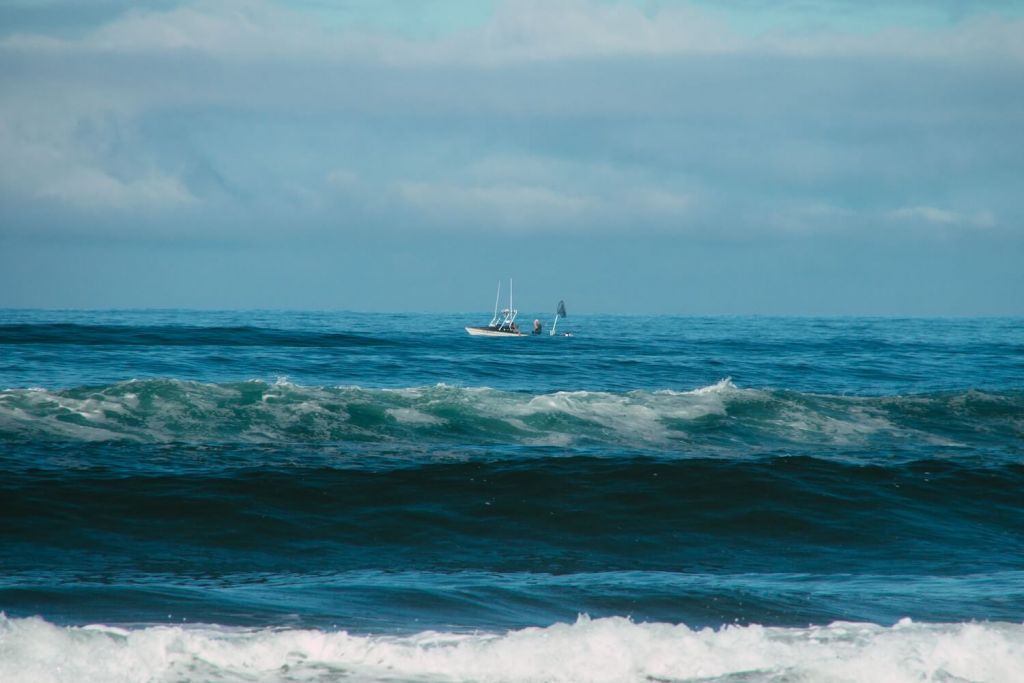
On this page:
Deep-v hull, displacement hull with keel, flat bottomed and pontoon hulls.
The multihull is the absolute winner in this list, so let's start there. Multihulls are incredibly stable , especially if they consist of two separate hulls (most sailboats). It is generally the most stable hull design out there, in most situations. The exception are extreme weather (and especially wave) conditions. With very large waves, I'd say a prefer a very deep keel design over a multihull.
So why is the multihull on sailboat the most stable, but not on powerboats in the overview above? Well, sailboats and powerboats have different hull types . They move through the water differently, which really impacts the stability of the multihull design. Sailboats have displacement hulls, but powerboats typically use planing hulls. Planing hulls glide over the water and displacement hulls move through the water.
This means that:
- multihull sailboats are displacement multihulls
- multihull powerboats are planing hulls
That simple difference really impacts the stability. I would say that for planing hulls (so powerboat) Deep-V hulls are more stable in most situations. More on that one later.
Generally, displacement hulls are a lot more stable than planing hulls, since they are submerged continuously. So the elements can't push them around as easily as planing hulls.
If you're interested in this kind of stuff, make sure to check out my full Illustrated Guide to Boat Hull Types here. There, I discuss all different hull types in a quick overview. For an in-depth look at displacement hulls, make sure to check out this article .
On Sailboats
Examples: catamarans, trimarans
Before we look at multihulls at powerboats, I want to start with sailboats. Multihull sailboats are incredibly stable. You definitely recognize these hulls: catamarans and trimarans are becoming more and more popular. The design uses two separate hulls, connected by a broad deck. This makes these boats very wide, which increases stability massively.
The two hulls are either regular displacement hulls - so it's like tying two monohull sailboats together - or semi-displacement hulls. This is a hybrid between displacement and planing. If you're interested, you can read a detailed overview of semi-displacement hulls here .
There are conditions where multihull sailboats perform worse than monohulls, and that is in extreme waves. Multihulls are a lot less agile, and because of their width, very large waves can be a problem. Not to worry: it is extremely hard to capsize a catamaran. But they can get pretty beat up when they get kicked around and receive a couple of punches.
On Powerboats
Examples: Cathedral, Dory
There are "multihull" powerboat designs out there. This design really looks like a small catamaran, but you wouldn't say so above the waterline. Powerboats with this design aren't particularly broader than their regular cousins. So the stability is a bit less compared to true catamarans. This design just doesn't make use of the enormous stability improvement thanks to the broad beam.
Multihull powerboats are mainly more stable in low and moderate chop (waves). For rough chop, Deep-V hulls are the better alternative.
Examples: powerboats
Deep-V hulls are a pretty new design, and are somewhat the powerboat's take on the sailboat's keel hull. A Deep-V is sort of a shallow keel design, that runs from front to aft, and results in a flat back to allow for planing. In other words, it's a planing keel design.
This allows two things: it can plane, so it is fast, but it's also a lot more stable and comfortable than flat bottom hulls. Waves won't push these boats around easily, as with flat bottoms. So in a way, it's best of both worlds.
Deep-V Hulls are so stable, that people even use them (safely) in rough coastal waters. They are known to hold their own pretty well in all kinds of conditions.
But: they are a type of planing hull. And as we know, planing hulls are generally less stable than displacement hulls.
Example: Sailboats
There's a bit of a debate on displacement hulls. Without a keel, they are probably the most unstable hull design out there. Really, they roll so incredibly easily. A great example of this are canoes. Canoes have displacement hulls. They glide effortlessly through water, because they are super smooth. But they also capsize the moment you put step onto them.
But displacement hulls have a lot of incredibly advantages. They are incredibly buoyant. They are heavier, making them more reliable and comfortable. They can cary enormous loads.
So we don't want to miss out on those because it tends to roll. Luckily, a simple extra feature will fix all of this: the keel. Sailboats use all sorts of keel design to counter the hull's tendency to roll over.
A good rule of thumb is: the deeper the keel runs, the more stable the hull will be.
So if you're looking for a sailboat to cross oceans on, make sure it has a long, long keel.
However, this doesn't mean it is really stable hull all of a sudden. Displacement monohulls can roll excessively in large waves. It's that typical sea-leg-tester that makes so many people sick. So if your definition of stable is 'steady', this one is not for you. However, if your definition of stable is 'reliable', this is a good option. Their roll is misleading: displacement hulls that have a good keel are incredibly hard to capsize.
Examples of flat bottomed hulls: rafts, row boats
If you are going to use the boat exclusively on small, calm bodies of water, flat bottomed hulls really make sense. You might not have expected them on this list, but the flatter the hull, the more stable it is.
The general rule is: the flatter the hull, the more stable.
So why are not all boats using this hull design? Well, even with a little chop, these boats will quickly become the most uncomfortable ride you've ever been on . Oh, and they steer like crap.
Flat bottomed hulls have a long tradition - I think it was probably the first boat hull design that every existed. Rafts have flat bottoms, and so do row boats. Most modern flat-bottom hulls are not entirely flat, because flat bottoms tend to be very choppy and not handle very well.
As with anything, there are more answers to the same question. But it's not super complex. If you're looking for the most stable boat out there, first make sure you know what you're looking for. Where and when are you going to use the boat?
Good rules of thumb:
- if it needs to go fast, you need a planing hull
- if it needs to be comfortable, you need a displacement hull
For planing hulls, you want some sort of shallow keel (multihull or Deep-V hull). These are the most stable in most conditions.
For displacement hulls, you want a multihull. If you go with a monohull, remember: the deeper the keel, the more stable it will be.
Leave a comment
You may also like, semi-displacement hulls explained (illustrated guide).
If you want to know exactly what a semi-displacement hull is, this article is right for you. Here, I explain simply what it is, how it works, and why it's different …
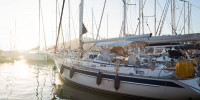
A Complete Guide to Displacement Hulls (Illustrated)

The Illustrated Guide To Boat Hull Types (11 Examples)
- Choosing A Powerboat Hull
Choosing a Powerboat Hull
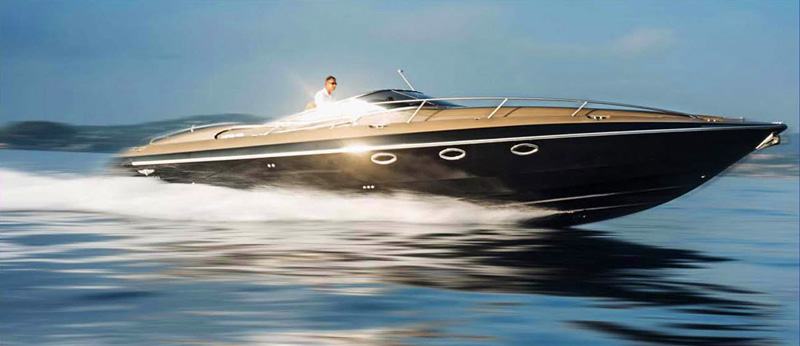
Types of Hull
Power boat hulls are divided into three main types:
- Displacement
- Semi-displacement
- Planing hulls
Hull types can have a variety of sub-types, closer to each end of the scale. When choosing your hull always consider your intended usage and your budget.
The size of your power boat will also be a factor in your choice of hull type. If you are considering a large power boat you will be less likely to choose a Full Planing hull. Large Fast Planing hulls require expensive engines, use large amounts of fuel and operating costs are high.
We've put together this list of the different types of power boat hulls available:
Heavy Displacement
Heavy Displacement Hulls include such craft as tugs and deep sea trawlers, with the stern rising above waterline. The Heavy Displacement hull has to be able to carry great loads and in the case of tugs, be able to get a grip on the water in order to do its job properly. The hull speed of this type of vessel is generally less than that of other types.
Medium Displacement
This type of hull includes most regular work boats, general fishing boats and the pleasure boats. For higher speeds consider Semi Displacement or Planing hulls.
One important factor to consider is that Displacement and Semi Displacement hulls are generally considered better Sea Boats and are more suitable for offshore cruising than the Planing Hull.
Semi Displacement or Semi Planing Hulls
These hulls fit in between the Displacement and the Planing hull types. The stern of the Semi Displacement hull is lower and designed to be always below the water. As with Displacement hulls, Semi Displacement hulls can be driven harder, but at the expense of greater fuel consumption and again the stern will tend to dig in at higher speeds. Choose this type of hull when planning to undertake extended cruising - cruising that regularly involves cruising distances of over 100 miles.
Planing Hulls
Planing hulls are very popular, they make great pleasure boats if you are prepared to install sufficient power and pay the larger fuel bills. Planing hulls do not like being operated at low speeds. They throw a most unfriendly bow wave. Planing hulls are not the best of sea boats especially in severe conditions.
Round Bilge
Hulls that are intended for Passage making will most likely be of the round bilge hull form. It is possible to design a Semi Displacement round bilge or round chine hull but the type is more suited to the chine hull configuration. Round bilge can be used for any displacement type hull especially those that are to be used for long distance voyaging.
Radius Chine Building Techniques
These boats are easy to build and exhibit all of the advantages of both chine and round bilge hull forms. These radius chine hulls represent a new development that has been made possible by the technology offered by modern computer assisted yacht design. These soft chine hulls have the capacity to offer the soft ride that we have often desired in a round bilge or chine hull form, but seldom achieved.
Power Catamarans
These boats are becoming increasingly popular and come in a variety of hull configurations. It is possible to design Displacement, Semi Displacement and Planing hulls to be used with the catamaran concept. Semi Displacement Power Catamarans offer comfortable, roomy and economical cruising powerboats.
Share this article
You might like.

Sign up to our newsletter
By submitting this form, you agree to our Privacy & Cookie Policy
Change units of measure
This feature requires cookies to be enabled on your browser.
Show price in:
Show lengths, beam and draft in:
Show displacement or weight in:
Show capacity or volume in:
Show speed in:
Show distance in:

INQUIRE ABOUT AVAILABILITY
Follow us on social.

CENTER CONSOLE
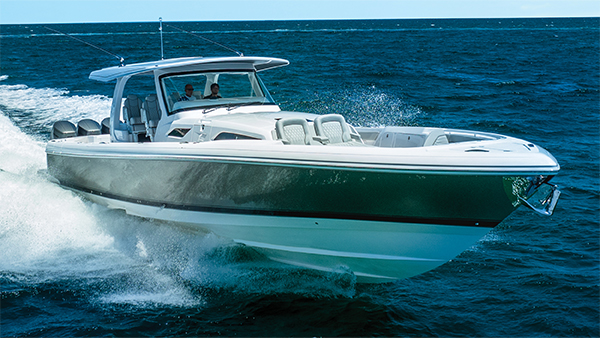
50 EVOLUTION
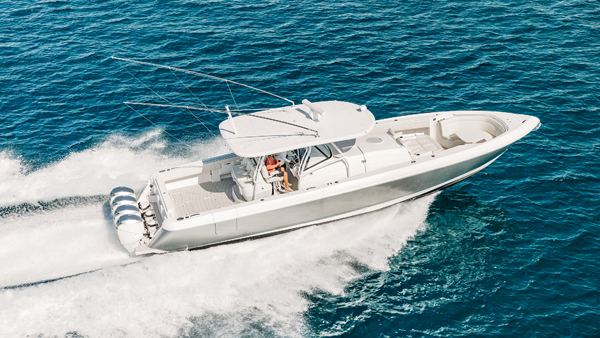
475 PANACEA
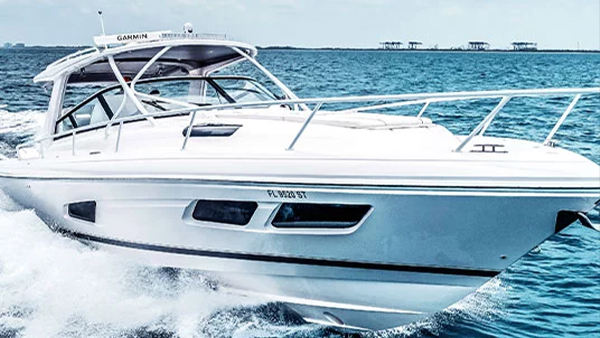
438 EVOLUTION
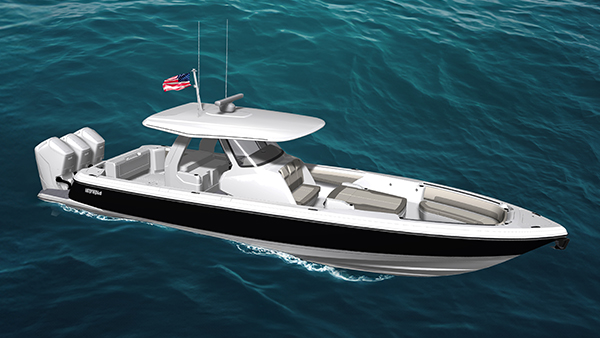
427 NOMAD FE
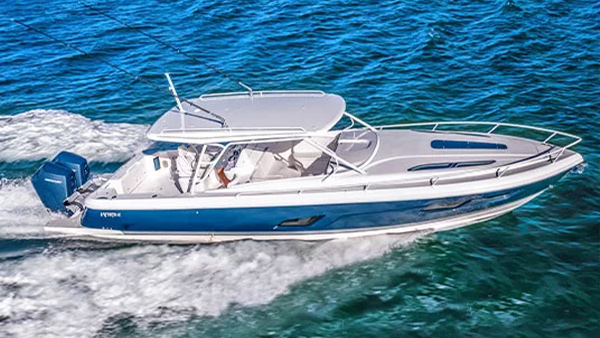
407 NOMAD FE
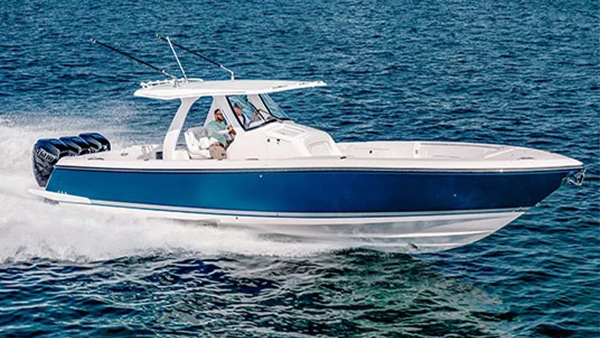
375 NOMAD SE
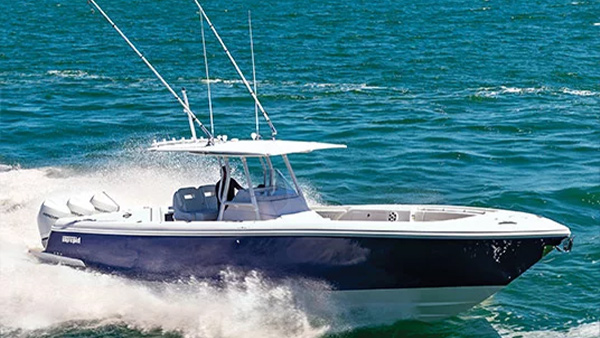
375 NOMAD FE
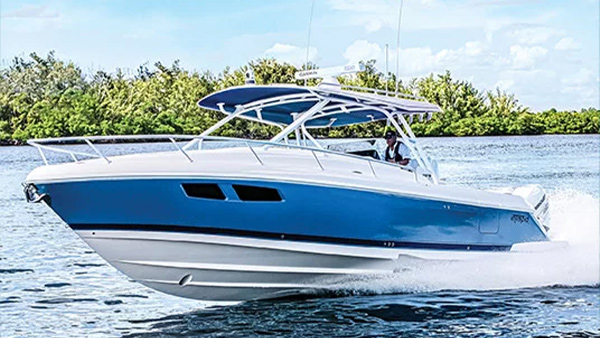
345 NOMAD SE
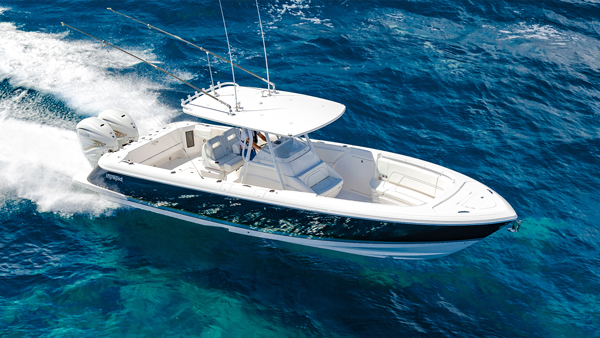
345 NOMAD FE
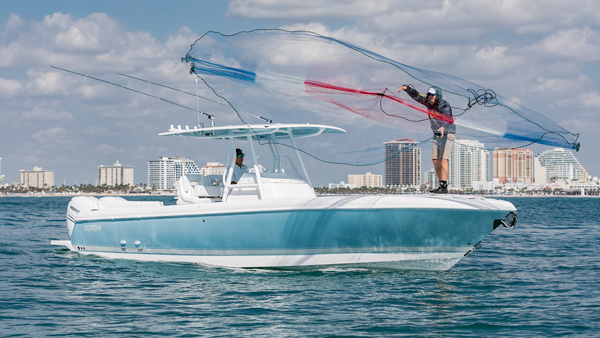
477 Evolution
- BUILD YOURS
- INTREPID DIFFERENCE
- VERSATILITY
- INTREPID NATION
Benefits of Intrepid’s Revolutionary Stepped Hull Design

We see it over and over again. The pleasant surprise – even shock – of an experienced boater taking the helm of an Intrepid stepped-hull powerboat or sport yacht for the very first time and getting it up on plane – especially if they’re out on rough or choppy water. They can’t believe how smooth, dry and sure-tracking an Intrepid is compared to any other boat they’ve even driven.
An Intrepid outboard powerboat feels like it’s floating on a cushion of air. Because it is.
THE INTREPID DIFFERENCE
First introduced on Intrepid powerboats in 1989, the company’s patented stepped-hull design is distinctly different from the hulls on other powerboats – in concept, design, engineering, and especially in performance.
Where Intrepid outboard powerboat and sport yacht hulls differ is in the forward panel, which is at a steeper longitudinal angle along the keel than the aft panel. These offset hull panels create more lift aft than at the step itself, so the boat runs with a slightly bow-up attitude, keeping it drier than the flat running angle of traditional hulls, which have hull panels at equal declivity.
The revolutionary large stepped hull on an Intrepid powerboat or sport yacht is the primary reason why it delivers a smoother, drier ride and can turn and maneuver so effortlessly.

Unmatched Maneuverability As you turn any boat, simple physics dictate that the bow naturally wants to go down. Aboard many other boats, which tend to run flatter or slightly bow-down to begin with, this is a “skittish” situation. The bow can actually dig into the water, which can cause the back end of the boat to “break loose” and the boat to literally skitter across the top of the water – moments that can unnerve any captain and crew.
The tulip-shaped (convex or flam) bow entry on our outboard powerboats and sport yachts adds buoyancy to the vessel, and further complements the extraordinarily efficient lift, superior handling and wave-crushing properties of the offset panels in our signature large-step hull design.

Superior Seakeeping, Unparalleled Confidence The safety of all on board is paramount to a carefree day on the water. The sure-footed handling and tracking of an Intrepid outboard powerboat or sport yacht instills unmatched levels of confidence in any captain, secure in the knowledge that he or she is at the helm of a luxurious custom powerboat or sport yacht with the industry’s highest standards for seakeeping, safety and reliability.

The World’s Most Advanced Fabrication Techniques Our innovative stepped hull design combines with the world’s most advanced fiberglass powerboat fabrication techniques. Yet another game-changing first from Intrepid, our vacuum bagging and resin infusing of the hand-layered, fiberglass fabrics that form the hull, deck and liners of an Intrepid powerboat make it lighter, stronger and more fuel-efficient – results that put Intrepid in a class by itself.
THE FINEST CUSTOM POWERBOATS AND SPORTS YACHTS ON THE WATER
When you combine the smooth-running, dry-riding, sure-footed maneuverability delivered by an Intrepid’s patented stepped-hull design with the industry’s most advanced fabrication techniques, it all adds up to the luxury of an outboard powerboat or sport yacht that instills unmatched levels of pride and confidence in anyone fortunate enough to own one.
To start custom-building your one-of-a-kind Intrepid, contact our Dania, Florida, Sales Center at Harbour Towne Marina today: 954-922-7544 or visit IntrepidPowerboats.com .
Most Popular

LATEST NEWS FOR JUNE 2024

LATEST NEWS FOR MAY 2024

LATEST NEWS FOR APRIL 2024

LATEST NEWS FOR MARCH 2024
Thank you for your interest in intrepid power boats.
- First Name *
- Last Name *
- Hidden Channel
- Hidden Source
- Hidden Medium
- Which Model are you interested in? * 51 PANACEA 50 EVOLUTION 438 EVOLUTION 43 NOMAD SE 43 NOMAD FE 41 PANACEA 41 VALOR 375 NOMAD SE 375 NOMAD FE 345 VALOR 345 NOMAD SE 345 NOMAD FE 300 NOMAD
- Phone This field is for validation purposes and should be left unchanged.
- Stay up to date with all the latest Intrepid information! In our newsletter you'll hear from the President of Intrepid, Ken Clinton, as well as other team members.
Dudley Dix Yacht Design
News about what is happening at Dudley Dix Yacht Design, from new designs to boat shows or anything else of interest to our followers.
Friday, April 13, 2012
Ost power 20 - an international effort.

No comments:
Post a comment.
Log in or Sign up
You are using an out of date browser. It may not display this or other websites correctly. You should upgrade or use an alternative browser .
Rudder or thrusters
Discussion in ' Boat Design ' started by D_m_m , Mar 4, 2011 .
D_m_m Junior Member
Hello, Total amateur’s question - keeping in mind offshore, displacement, non-commercial boat around 40’ length, cruising speed below 8 knots, single convention shaft with propeller, will it be wise to use 2 tunnel thrusters in the bow and stern instead of rudder? The background for the question is to concentrate on the underwater hull design for fuel economy / speed. If I am not mistaken, there are some specific cases when rudders are not used, f.e. work boats with azimuth thrusters. Can you please comment the question and / or provide some more examples when rudders are replaced.
Submarine Tom Previous Member
Generally speaking: Rudder -Tom
Submarine Tom said: ↑ Generally speaking: Rudder -Tom Click to expand...
michael pierzga Senior Member
On a small craft, how will you keep the forward thruster in the water as the vessel moves thru a seaway ?
michael pierzga said: ↑ On a small craft, how will you keep the forward thruster in the water as the vessel moves thru a seaway ? Click to expand...
Olav naval architect
I'd go for rudders, too. Keep in mind that transverse thrusters don't really work when the vessel is under way and their transverse flow is overlaid by the flow along the hull, resulting in no or almost no transverse thrust. In addition, the thruster tunnels will produce quite a lot of drag which might be larger than the resistance of a conventional rudder blade of proper size. According to Holtrop & Mennen* the drag coefficient of a bow thruster opening is somewhere between 0.003 and 0.012 (so you have some numbers to play with). Just my two cents... *J. Holtrop and G. G. J. Mennen: "An Approximate Power Prediction Method", International Shipbuilding Progress 1982, Vol. 29, pp. 166-170.
PAR Yacht Designer/Builder
On a typical 40' boat, you would only need one prop to move her around and if straight shaft or sail drive a single rudder. This is less resistance then a few pods scattered about the bottom of the boat. The only reason you'd want to tolerate the increased resistance of pods, would be to satisfy some operational requirement, such as precise station keeping or better maneuverability on certain hull shapes. This falls back or your satisfying SOR goals, established in the preliminary design stages.
Olav and PAR, thank you I will keep the link for home assignment, with the current knowledge I hardly can swallow it http://www.marin.nl/web/News/News-items/An-approximate-power-prediction-method.htm The very first idea was to close both our reasons with jet thruster (regulated thrust, only 5 holes in the hull 1 x 90 mm and 4 x 45 mm), but cannot tolerate the ideas of letting the water inside the hull and complicity of the entire system. I take time out, the question might be changed for a kind of "how to integrate a rudder into fuel efficient hull and find low resistant and simple maneuvering solution"
- Advertisement:
Thrust vectoring is simple and efficient (no rudder too), but you only need one unless there are special circumstances. An outboard is a classic and simple thrust vectoring device.
Rudder vibrations Help
Proa Rudders, from Balkan Shipyards
Unusual rudder placement
What Characteristics Define a Rudder ?
Fiberglass Rudder Shoe
New Rudder for a West Wight Potter 19
Changing rudder post angle
Rudder Design
Rudder area question
Rudder Placement and Size in Relation to Prop on Submarine
- No, create an account now.
- Yes, my password is:
- Forgot your password?


IMAGES
VIDEO
COMMENTS
A truly flat-bottomed boat has zero degrees of deadrise. Most powerboat hulls have some deadrise, giving the hull bottom its "V" shape when viewed from the bow or stern. The deep-V hull was developed in the late 1950s and proved to be optimal for high-speed offshore vessels, with transom deadrise of 18 to 24 degrees.
Displacement Speed: 9.6 knots. Full-Displacement Hull: Nordhavn 63. Top Speed: 9.8 knots. Displacement Speed: 10.1 knots. But if all you really want is a working knowledge of those basics so you can be a more informed boater, a good place to start is not erotica but rather with a knife and a box.
Powerboat Hulls Explained. Power boat hulls are divided into three main types namely, Displacement, Semi-displacement and Planing hulls. Each hull type can have many sub types, which are closer to one or other end of the spectrum. Considering each hull configuration in detail will reveal its benefits and disadvantages, your choice will be ...
This design is commonly used in powerboats, speedboats, and watercraft designed for activities that require high speeds. Characteristics of Planning Hulls: Shape: Planning hulls often have a flatter, more streamlined shape compared to other hull designs. This shape reduces hydrodynamic drag and allows the boat to transition onto the plane more ...
One of the most popular hull design for modern-day powerboats is the Deep Vee hull. And that's as cool as it sounds. Deep V-Hull. This is a type of planing hull that combines the best of both worlds. These types of hulls are very popular on modern-day powerboats, and no wonder. With a V-shape that runs from bow to stern, deep into the water ...
Modified-V. Sometimes called a warped plane, this is the most common hull for small boats, because it combines some of the best characteristics of the other shapes. The flatter sections toward the stern add stability as well as increase the speed, just like a flat-bottom. The wedge-shaped forward hull cushions the ride like a deep-V, and also ...
By Jim Russel The Vee-bottom hull is the most common design in modern performance powerboats. The Vee design has a number of variations and near-endless modifications - including the pad-vee design - that can enhance particular handling characteristics of the boat. If going fast is the objective, it's worthwhile knowing just how a vee pad can affect vee hull performance.
Hull Design: Planing Hull Efficiency. October 22, 2020. The overwhelming popularity of the planing hull is a direct result of its pure speed potential. View Full Article. In Boat Evaluation Tags Hull Design. ← Hull Design: Your boat's bottom... and yours Hull Design: "Slab Sided" Hulls →. SORENSEN's GUIDE TO POWERBOATS. Eric Sorensen ...
A boat's weight—and its distribution fore and aft—is central to hull design of any kind. We design the underwater volume of a hull to be distributed in a way that matches the optimal fore and aft center of gravity of the assembled boat plus her occupants and gear. This "center of buoyancy" is the volumetric center of the shape of the ...
V-Shaped Hulls. "V-shaped" hulls are planing hulls, and are the most common type of hull for powerboats. Deep v-shaped boats are designed to plane on top of the water at higher speeds and provide a smoother ride through choppy water. These boats are usually equipped with a larger engine than flat or round-bottomed boats.
CFD For Powerboat Design, Part 1. By Clay Ratcliffe, May 24, 2021. Scan data are rendered into digital design files suitable for performing computational fluid dynamics (CFD) modeling like this one to test the hydrodynamic performance of the vessel. In its earliest days, composite boatbuilding was open to most anyone who could cut fiberglass ...
Deep-V Hull. Examples: powerboats. Deep-V hulls are a pretty new design, and are somewhat the powerboat's take on the sailboat's keel hull. A Deep-V is sort of a shallow keel design, that runs from front to aft, and results in a flat back to allow for planing. In other words, it's a planing keel design.
Power boat hulls are divided into three main types: Displacement. Semi-displacement. Planing hulls. Hull types can have a variety of sub-types, closer to each end of the scale. When choosing your hull always consider your intended usage and your budget. The size of your power boat will also be a factor in your choice of hull type.
However, not all innovations work in practice, or deliver good value for boat owners. We interviewed John Canada, President of Ocean5 Naval Architects, to help identify the best ideas in the latest designs. Here are our top five design and technology innovation picks. The new Seavee 270Z double-step hull aims to improve performance in a wide ...
Well, whether you subscribe to this metaphor or not, you can't deny that the subject of powerboat hull design starts out pretty simple and quickly gets complicated. A layman could easily spend hours, if not days and years, poring over textbooks and tomes that explain such arcane (at least to the average boater) concepts as warp and prismatic ...
The Formula 1 Powerboat World Championship (also F1) is an international motorboat racing competition for powerboats organised by the Union Internationale Motonautique ... The tunnel hull design creates aerodynamic lift due to a 'wing' formed by the deck and under surface of the hull. This increases lift and reduces drag, so that at speed only ...
This general purpose powerboat hull design I'm thinking of should be available in a number of sizes; I'm thinking 10, 12, and 15 meters, hopefully designed such that its other dimensions scale parametrically with its length. It should be a V-bottom planing hull. The basic design should be for a single inboard or pod drive propulsion system ...
An Intrepid outboard powerboat feels like it's floating on a cushion of air. Because it is. THE INTREPID DIFFERENCE. First introduced on Intrepid powerboats in 1989, the company's patented stepped-hull design is distinctly different from the hulls on other powerboats - in concept, design, engineering, and especially in performance.
The Ost Power 20 is a new powerboat design that was commissioned by Ost Yachts of Moscow, Russia. The design brief was for a production GRP boat of very modern "stealth" styling and which could be economically shipped internationally in containers. ... The hull and deck plugs were made on a 5-axis router in Virginia, USA and were shipped to ...
DUDLEY DIX YACHT DESIGN. Ost Power 20 . Versatile new powerboat ~ Production builder ~ Modern styling ~ Sportfisherman ~ Diveboat ~ Patrolboat Ost Yachts website. MENU. Home Overview Email Designs Materials ... Hull draft - 0.33m [1' 1"] Displ - 1425kg [3140lb]
Total amateur's question - keeping in mind offshore, displacement, non-commercial boat around 40' length, cruising speed below 8 knots, single convention shaft with propeller, will it be wise to use 2 tunnel thrusters in the bow and stern instead of rudder? The background for the question is to concentrate on the underwater hull design for ...